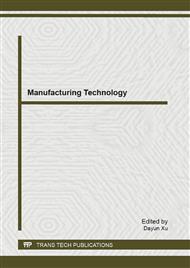[1]
Machado, J., E. Seabra, J.C. Campos, F. Soares, and C.P. Leão, Safe controllers design for industrial automation systems. Computers & Industrial Engineering, 2011. 60(4): pp.635-653.
DOI: 10.1016/j.cie.2010.12.020
Google Scholar
[2]
Baresi, L., M. Mauri, and M. Pezzè, PLCTOOLS: Graph Transformation Meets PLC Design. Electronic Notes in Theoretical Computer Science, 2002. 72(2): p.79.
DOI: 10.1016/s1571-0661(05)80532-8
Google Scholar
[3]
Rankin, D.J. and J. Jin, A Hardware-in-the-Loop Simulation Platform for the Verification and Validation of Safety Control Systems. Nuclear Science, IEEE Transactions on, 2011. 58(2): pp.468-478.
DOI: 10.1109/tns.2010.2103325
Google Scholar
[4]
Machado, J., B. Denis, and J.J. Lesage. A generic approach to build plant models for DES verification purposes. in Discrete Event Systems, 2006 8th International Workshop on. (2006).
DOI: 10.1109/wodes.2006.382508
Google Scholar
[5]
Machado, J., Influence de la prise en compte d'un modèle de processus en vérification formelle des Systémes à Evénements Discrets, in Departamento de Engenharia Mecânica2006, Ecole Normale Supérieure de Cachan: Cachan. p.176.
Google Scholar
[6]
Preusse, S. and H.M. Hanisch. Verifying functional and non-functional properties of manufacturing control systems. in Dependable Control of Discrete Systems (DCDS), 2011 3rd International Workshop on. (2011).
DOI: 10.1109/dcds.2011.5970316
Google Scholar
[7]
S. Preuße, C. Gerber, and H. -M. Hanisch, Hardware-In-The-Loop Simulation and Verification of Manufacturing Control Systems, in Proceedings of 18th IFAC World Congress2011: Milano, Italy.
Google Scholar
[8]
Moon, I., G.J. Powers, J.R. Burch, and E.M. Clarke, Automatic verification of sequential control systems using temporal logic. AIChE Journal, 1992. 38(1): pp.67-75.
DOI: 10.1002/aic.690380107
Google Scholar
[9]
Alur, R. and D.L. Dill, A theory of timed automata. Theor. Comput. Sci., 1994. 126(2): pp.183-235.
Google Scholar
[10]
Behrmann, G., A. David, K.G. Larsen, P. Pettersson, and W. Yi, Developing UPPAAL over 15 years. Software: Practice and Experience, 2011. 41(2): pp.133-142.
DOI: 10.1002/spe.1006
Google Scholar
[11]
Clarke, E.M., E.A. Emerson, and A.P. Sistla, Automatic verification of finite-state concurrent systems using temporal logic specifications. ACM Trans. Program. Lang. Syst., 1986. 8(2): pp.244-263.
DOI: 10.1145/5397.5399
Google Scholar
[12]
Systems, F.A.A. Festo®. [cited 2012 April 04th]; Available from: http: /www. festo. com/net/startpage.
Google Scholar
[13]
Pahl, G. and W. Beitz, Engineering Design – A Systematic Approach1996, London.
Google Scholar
[14]
Pugh, S., Total design : integrated methods for successful product engineering1991: Harlow : Prentice Hall, cop. (1991).
Google Scholar
[15]
Drejer, A. and A. Gudmundsson, Exploring the concept of multiple product development via an action research project. Integrated Manufacturing Systems, 2003. Vol. 14: pp.208-220.
DOI: 10.1108/09576060310463163
Google Scholar
[16]
Ulrich, K.T. and S.D. Eppinger, Product Design and Development2000, New York,: McGraw-Hill.
Google Scholar
[17]
Jones, J.C., Design Methods, ed. ed1992, New York: Van Nostrand ReinHold.
Google Scholar
[18]
Kreith, Mechanical Engineering Handbook1999, Boca Raton: CRC Press.
Google Scholar
[19]
Tim Bray, T., Extensible Markup Language (XML) 1. 0 (Second Edition).
Google Scholar
[20]
Diethers, K. and M. Huhn, Vooduu: Verification of Object-Oriented Designs Using UPPAAL Tools and Algorithms for the Construction and Analysis of Systems, K. Jensen and A. Podelski, Editors. 2004, Springer Berlin / Heidelberg. pp.139-143.
DOI: 10.1007/978-3-540-24730-2_10
Google Scholar
[21]
Knapp, A., S. Merz, and C. Rauh, Model Checking Timed UML State Machines and Collaborations Formal Techniques in Real-Time and Fault-Tolerant Systems, W. Damm and E. Olderog, Editors. 2002, Springer Berlin / Heidelberg. pp.395-414.
DOI: 10.1007/3-540-45739-9_23
Google Scholar
[22]
SIEMENS. Solid Edge®. [cited 2012 April]; Available from: http: /www. plm. automation. siemens. com/en_us/products/velocity/solidedge.
Google Scholar
[23]
Systèmes, D. CATIA®. [cited 2012 April]; Available from: http: /www. 3ds. com/products/catia/welcome.
Google Scholar
[24]
Systèmes, D. SOLIDWORKS®. [cited 2012 April]; Available from: http: /www. 3ds. com/products/solidworks/overview.
Google Scholar
[25]
Yang, J., S. Hang, J. Cho, B. Kim, and H.Y. Lee, An XML-Based Macro Data Representation for a Parametric CAD Model Exchange.
Google Scholar
[26]
SCRA, STEP APPLICATION HANDBOOK ISO 10303 2006: NORTH CHARLESTON. p.181.
Google Scholar
[27]
Mandorli, F., H.E. Otto, and F. Kimura, A reference kernel model for feature-based CAD systems supported by conditional attributed rewrite systems, in Proceedings on the second ACM symposium on Solid modeling and applications1993, ACM: Montreal, Quebec, Canada. pp.343-354.
DOI: 10.1145/164360.164468
Google Scholar
[28]
Choi, G. -H., D. Mun, and S. Han, Exchange of CAD Part Models Based on the Macro-Parametric Approach. International Journal of CAD/CAM, 2002. Vol 2: p.9.
Google Scholar
[29]
Sivaloganathan, S., T.M.M. Shahin, M. Cross, and M. Lawrence, A hybrid systematic and conventional approach for the design and development of a product: a case study. Design Studies, January 2000. vol 21(1): pp.59-74.
DOI: 10.1016/s0142-694x(99)00004-6
Google Scholar
[30]
Anderl, R. and R. Mendgen, Analyzing and optimizing constraint structures in complex parametric CAD models. Geometric Constraint Solving and Applications, ed. B. . In: Brüderlin, Roller, D. (eds. ), , , , 1998, Berlin Heidelberg Springer-Verlag.
DOI: 10.1007/978-3-642-58898-3_4
Google Scholar
[31]
ISO10303. 2003; Available from: www. tc184-sc4. org.
Google Scholar
[32]
Silva, J.P.M.A., M.S. Pais, and A.A.C. Monteiro, Dados, comunicação e informação técnica na fabricação mecânica, in XIV Congreso Internacional de Ingeniería Gráfica, INGEGRAF, Editor 2002: Santander, Spain.
Google Scholar
[33]
Pierra, G., Context-Explication in Conceptual Ontologies: The PLIB Approach, in Proceedings of CE20032003: Madeira.
Google Scholar


